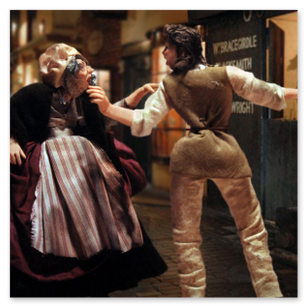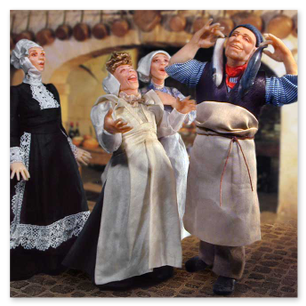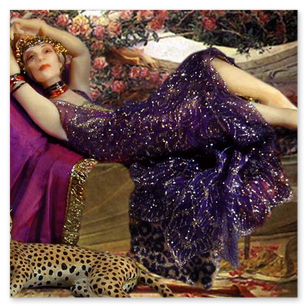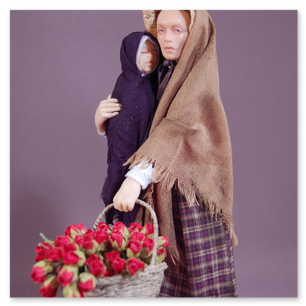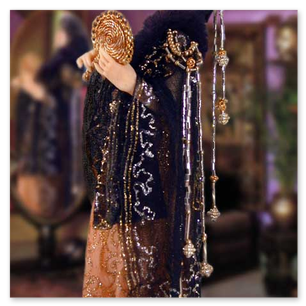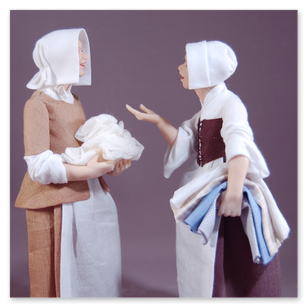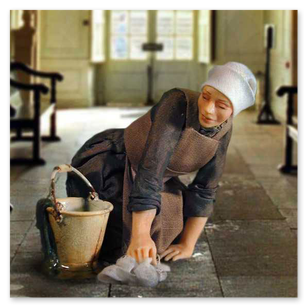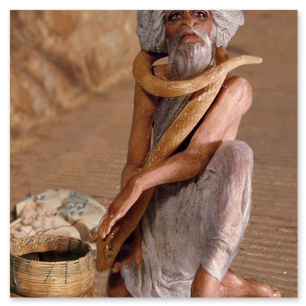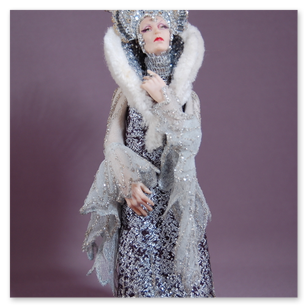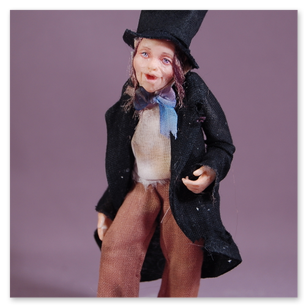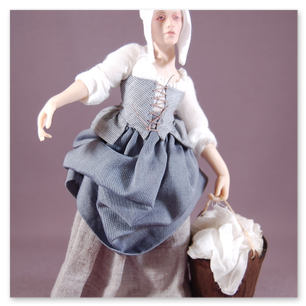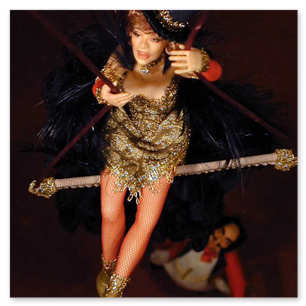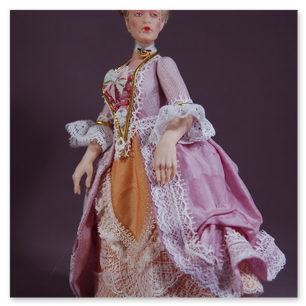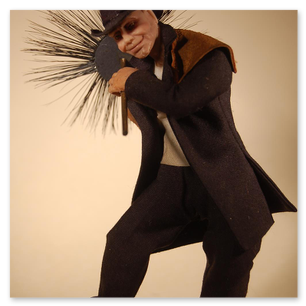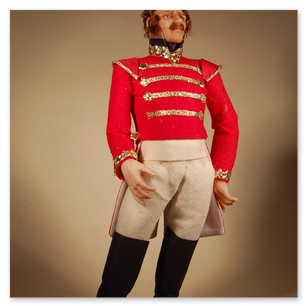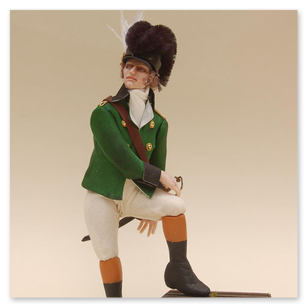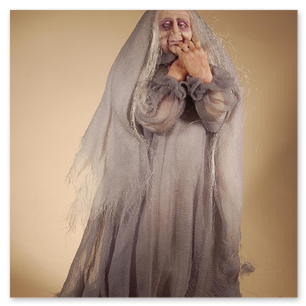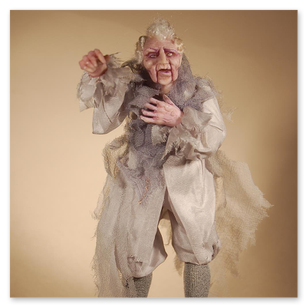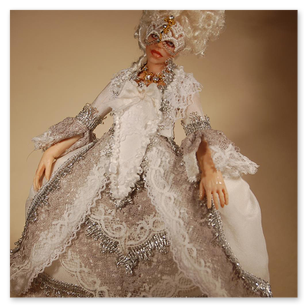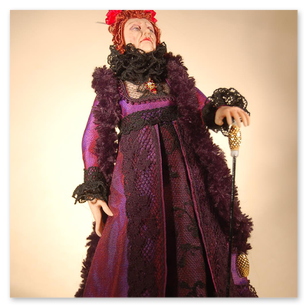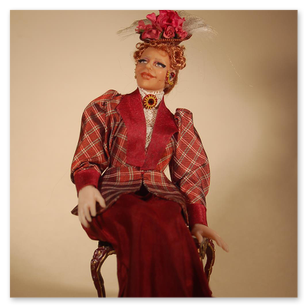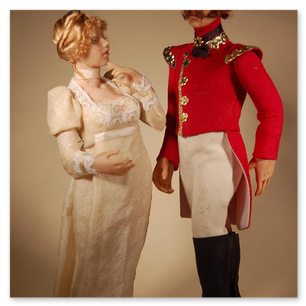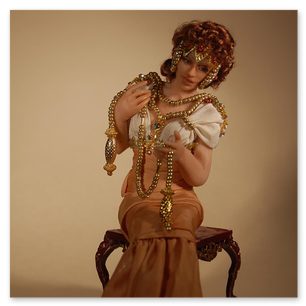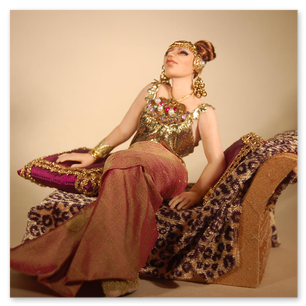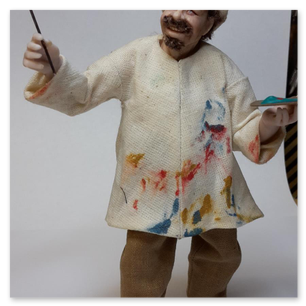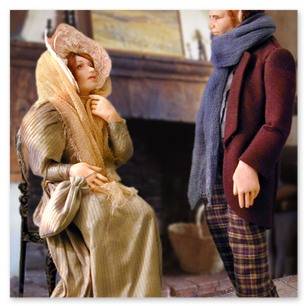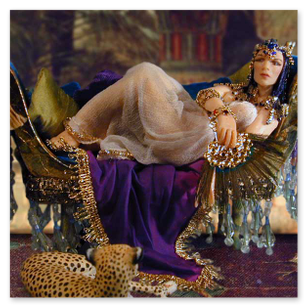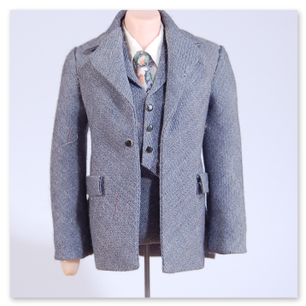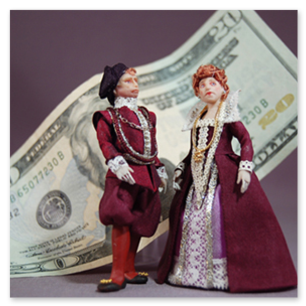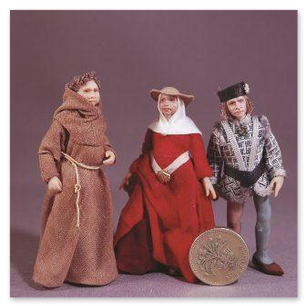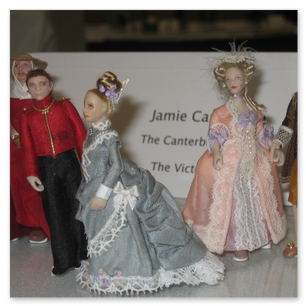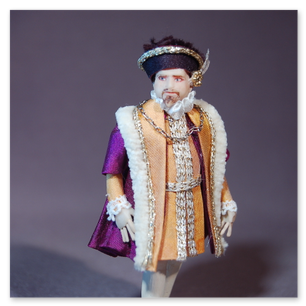James Carrington
Interviews > Internacional
James Carrington
James, tell us about the beginning… How did you start sculpting dolls?
Well, before I started with doll's house dolls I had been a dancer, which gives my dolls now movement; I had been in costuming, so I can dress the dolls - as I have always been in fashion.
In 1984 I needed a change. I had met a lady who made larger dolls, called Jill Bennett, we got talking and she invited me to become her partner and make doll's house dolls, which I knew nothing about!... It was the very early days… I went up to Birmingham to see the first doll's house show I'd ever seen, and discovered this huge world! So Jill and I started a business that was porcelain dolls. In those days they were very pretty and like Victorian original dolls. I wanted to do more realistic dolls, but the collectors weren't ready for that sort of thing… I went back into the theater for a little while. I did fashion again, I did other jobs from my 'past life', until one day I broke my ankle.
I had been trying to find a medium to work in, other than porcelain, because I don't feel comfortable in that… I was in bed, with my foot supported, I couldn't move for a long time. A friend came to see me and I remembered that down in my chaotic cellar, the basement, was a block of Fimo that we had bought seven years before, a plaster mold, and he brought them up. And suddenly I discovered what I had been looking for! It's been like that all time: the 'fates' were holding it on, very, very tightly!
I started to sculpt them, and experiment, and I found I could do them! I did a collection using new Fimo blocks. I contacted some people I had know from my 'past life' and one lady spoke to me that she couldn't see me then, she said I'd have to see her later. It turned out when I phoned her she wasn't there, so I had to phone somebody else. Now, this one invited me over to her shop and she had an assistant there. I still thought that people would like the pretty dolls. I'm a man, I like 'character' people; I'm an older person, so l like to do more realistic, more 'passionate' figures, to bring on my 'theater and drama' and dance, into it. I took them down, she bought a load of dolls from me and her assistant played with them, in a very interesting fashion!
Her assistant turned out to be Carol Hilbert and her husband was Steve Hilbert, form Chapel Road, who, I then discovered, was a famous man who did very working-class Dickensian pictures of disreputable public houses, and he had been searching for someone to make very realistic, dramatic figures. I made 5 and I sent them to him just to ask for criticism. He was so excited! They were going up to the Birmingham show and they asked if they could take them. That was during the week… I had a phone call on Monday morning to say that a riot had broken out, that there had been a fight with two ladies fighting over some of those dolls. They said: "your new career has just started!"
And it has been like that ever since… I suddenly realized that the 'gods' were with me and they have directed me and I relaxed!
Do you have any drawing background on anatomy or something to help you when sculpting?
I studied at Nottingham Art College, in the "old days", when you had anatomy classes, live classes, you drew nudes, dances… I'm very, very aware of the structure and the balance of the figure. That, to me, is the most important. Things like hands are vitally important because they are the punctuation into the story. They make sense out of it. Even figures in absolute silence must tell a story!
Among all the dolls you've made so far, which one is your favorite?
I'd like to think that the next doll is going to be my favorite one but… I had a book on dances, photographs of dances, and there was a photograph of a very, very old Japanese dancer, in terrible pink tights, an awful old kimono, frizzy hair with fans in them, his make-up was broken and cracked, and he held the most magical pose! He's called Katsuo Uno, a Japanese dancer. In the book they described him as being in his eighties, his work is very abstract, and he teaches very specialized groups of people around the world. And it was the joy of seeing this wonderful old man who wanted to share his things, I made - to me… - one of the most successful dolls. I took it to a show and people were mystified, quite shocked by him, and I realized I could never sell him. He was my 'special thing'. He inspires me! He's beautiful, almost tragic.
And which one do you prefer to make, female or male figures?
I think that if I have a story to tell, it doesn't matter. Somebody asked me, just before Chicago show, if I could make a drunken old man for her public house. She gave a description that was just so clear, that I love him dearly, for the moment! It's the moment that is most important.
So it is the story that inspires you?
Yes! It's the story. It's the drama side of me, the acting side of me… I like to try and get that information. It's something that my customers tell me, I sometimes achieve… They often tell me the story that the doll is trying to… which conveys to them. It's not my story, but if they tell me that, I know that I'll have a successful doll, because they are involved with it.
And in a more technical level, do you use many tools for sculpting?
No, I have a group of tools, and learned very quickly that one tool may only do two good things. And I keep that tool for those things. And I sometimes just experiment with others, and find that they have one or two jobs. I don't try to make one perfect tool to everything, nor have 20 tools. Because like every doll maker, I work in chaos… And if I only have three tools, it's easier to find the lost three tools than try and find them amongst the twenty tools… (laughs…)
As you might know, we have few miniaturists in Brazil, and even fewer miniature doll makers. What would be your advice to those who would like to give it a try, to start sculpting human figures? What would be your tips for beginners with very few resources around them?
Try and see as many photographs as you can, and see why one in particular moves you. It's so personal! You may try and copy another doll maker. There's no harm in that in the learning process… But relax and allow your own natural doll maker to emerge. It won't happen instantly.
And be very careful who you show it to. Show it to somebody who is like yourself, who is a relaxed person. Don't show it to "school teacher" who will disapprove
The one thing I would say is: the doll makers I love most are the ones that never yet feel they have made the perfect doll! That there is always, always, room for change and improvement. It is vital! I've seen some people who are just satisfied with what they do and they don't develop their skills.
Find other doll makers that you like, who are kind and supportive, and share your things. You might be very new to it, but you have got something to offer.
Try and keep your proportions correct. The only thing that I really do is to work from a chart. Stick to that. Because if you forget the chart and start a new doll, and compare it to the one you've just made, very soon you'll be a quarter of an inch out, a few millimeters out. When you copy that one, each time you'll get more and more distorted.
I did a talk for a doll club in England and I asked for questions. One French lady asked something that I did not know the answer to it until I thought about it. She was asking about the "high parts" of the face: if I wanted "high" cheek bones, did I create the hollow first or did I add the cheek bones? After I thought about it I realized I was making mistakes. I was adding cheek bones, hoping that the high part would make the rest of it hollow. And what I was actually doing was making the head bigger and bigger! And I suddenly thought "I must remember to create the hollow part first, and maybe the high part will be enough!" It's only a tiny bit. It's very easy to have your dolls become cartoon dolls and get out of proportion. Have "props" that you rely on, well-proportioned furniture, for example. And sit them in that to get the sense of proportion.
Don't measure yourself! When Jill and I first showed a group of dolls, people bought them, but a very good buyer came and said: "I love your dolls, it's such a pity about the orangutan arms". Jill and I were most annoyed about that, because we measured them according to ourselves. And the lady who bought them said: "but have you seen how long your arms are?"… And actually we had been complaining how short the shirts all were in the sleeve… I saw one of those dolls many years later and I was horrified that we thought that that looked normal!
If you want to make yours based on you, you do it! I get criticized by some people who say 'my' hands are too big. Actually, they are rather large. But I have large hands and I love the drama of the large hands. Make sure that men have got strong hands and good big feet. Nothing worse than having them in tiny looking feet.
Some dolls are actually hard to get what they are. Sometimes it feels that the dresser has used a female doll and dressed it as a man.
Think about strength! Women are softer, rounder; the man is more angular. That gives the appearance of masculinity.
And as we are in the measures topic, have you ever been tempted to try smaller scales?
I'm now doing 1/24th scale…
It's a big challenge, isn't it?
I've been asked to do it many, many years ago by a porcelain doll-maker in 1/24th. I'm using paired molds in 1/24th because porcelain shrinks. So, it's slightly larger.
I thought I couldn't do it, but sculpting that, which is much more suggesting sculpture, I found fascinating.
We have in our scale doll making the depth of a shadow, the grooves around the nose, are very shallow. A little darker color around or in that will really bring out the fact that there is a crease in that. Because in the human head you can see that line, but in a tiny doll, it's harder. So, use a tool right, paint and just tint that and it brings a roundness to the face.
I was convinced that because I have large hands I couldn't dress that small… Recently I have been coerced, led, into thinking that this might be a good idea. I spent weeks telling myself that "I can't do it". Until I thought: "try a simple one first". A medieval costume is much more simple. And I shocked myself when I found out that it actually worked!
The only trouble was: within 2 days I decided that I must experiment with a Victorian dress. I could have taken the Victorian period of the crinolines, the simple gathered skirt, but I'm not like that.
I have tried a draped front and a gathered bustle with a foundation and actually, hours later, I was so shocked! Not only did it look better than I thought I could ever do, I found it delightful to do!
It means slightly different techniques, a lot less sewing, because this bulks, and a lot more careful, careful gluing.
And you have to be careful about scale when it comes to fabric?
Yes, it is scale again. I'm a textile expert, I have dealt with textiles since childhood and somebody reminded me today that I have over 60 years experience. It's just that when I see something new, I get frightened, just like the newest person. I feel like I've gone back.
That's actually an encouragement for us newbies!
Yes! And this one of the things I love about teaching, which I'm passionate about. I watch people coming, thinking that they are going to be the class 'idiot', that we will laugh at them, and it's those that have those little 'triumphs', that thrill me more than anything.
And I have never finished a class without learning something new. Usually from somebody who's done it for the first time, and I can create "habits" that perhaps I don't need any longer, but it's what I do, and I can't change. They come up with questions that make you think! And you think "I must break old habits".
Is it a good idea to take pictures of your early work when you're learning something new? Then when you look back you can see your development?
Yes. And then again, I look at some old photographs and I think that I have lost my talent. Because distance from that doll makes them look better than I remember them.
I have a very dear friend who talks about the 10-minute-doll. She's been a very long established doll maker called Cat Wingler. We talked about that for 10 minutes a doll is so beautiful, and then you review it again and you see something about it that is so obvious, nobody else sees it, but we do. She says "if we sold that doll and we thought it was beautiful forever, we would probably never make another one". Because we're trying to find the ways to make the 'perfect doll'. It's a quest!
Has it ever happened that you have a certain doll that you picture in your mind and you couldn't translate into the actual real doll?
Yes! Regularly… I would want to make a very aristocratic lady and she has a life of her own. She will always want to be a hooker, a "torch figure". And I have tried to "fight" that doll. I usually end up ripping the elegant rig garbs and putting a red rig garb on it and I'm so thrilled that it has been so obvious!
When I'm teaching I always say: "bring in good ideas, because that will always start you off, but if the doll "wants" to do something else, don't fight it. Let it. Because "she" or "he" is stronger than you are". It's happened in class, when people get so frustrated.
The first time I taught, at a big school, a lady wanted to do a particular character holding a tankard of ale, and she couldn't do it. It was for her daughter, who had bought her the course, and she wanted to give it as a present. She got very frustrated and she dropped the doll once, somebody saw it from another angle and said "she's a torch singer!" This time we gave her the red wig, made a microphone, found some leopard skin fabric; we dressed her and it was the most wonderful doll!
What can we do if we are having some "creative block"?
Sometimes putting it in front of a mirror, when you are not sure, looking at in the mirror, or a photograph, just take a quick photograph, it will show you what it is, what you really want to do. But relax! The beautiful lady you want to do won't emerge until she's ready. The other one is ready now.
Sometimes I fight it, and now I know better. We can put it to one side in a gentle place and say "I don't know what story you're telling." Start another one. Keep it close. The danger is that you clear it away and then you have to take everything out and it takes up too much time, then it's too late to work on it, it discourages you.
I'm lucky. I live on my own. I create chaos everywhere and there's nobody to complain. If someone is looking after a husband or family, they take up a lot of time. You must insist that there must be a space in the day to do your dolls.
Is there anything you’d like to say to Brazilian artisans?
Look at your culture. Look at your roots and learn to treasure them! Look at your history, it's magical; and it will be magical to stranger' to your history.
Don't be shy when you present your work. Don't apologize for the mistakes. They can't see them.
I sent a doll to a lady customer and I told her "It's not quite what I wanted to do" and she screamed at me and said "Jamie, we can't see inside your head! We look at your work and we love what you've done. We don't think that there's another way of doing it!". And I love Sally for saying that to me! I share it with newer people and say: have confidence in it. Learn to be young and a child again. The damage is, as grown-ups we think we have to do things "correctly" and "properly". You might be missing new and magical things.
Give yourself freedom! Have a lot of fun!
And keep breathing while you're sculpting. We can tense our bodies. It's about learning muscle memory.
Keep it going and don't allow too much time in between. Just do a little bit each day. If you do too much, you'll start doubting yourself, you'll lose confidence. You start saying "I can't do it perfectly, therefore I won't start…" We all do it! Adults get taught very dangerous habits..
Try, by hook or by crook, to get to one of the big shows, and see these completely mad, old, happy, enthusiastic, crazy people, and realize you have joined the best work in face-lift in the world! You can't actually tell anybody just how old someone was, because they are always on a new thing, a new experiment, they find a new glue, or a new brush, and that's what keep people young!
I try to teach my students to behave like a Turkish rug-maker. They put a mistake into their work. Only the gods do perfection. If you try and be perfect, you'll offend the gods.
And you'll fail! (laughs...)
Miserably!... (laughs…)
And don't seek approval from others, give yourself approval. This is the most fun thing I have ever done! There isn't enough time in the world to complete all that I want to do.
I wish you can come to Brazil someday to teach!
One day… Because I love the Latin temperament! I have an English brain, but an Italian heart. I love the sounds. I love the faces in Brazil.
It's one thing I'm learning, because now I'm teaching in Holland and Scandinavia, and I'm learning yet again, that the Danish face has a little round cheek, that the Norwegian face has tiny little nose, the Dutch has a different look shape... it's so inspiring! I'm learning something new. You never ever stop learning.
There's a "roundness" to the Brazilian face, a "fullness", there's this passion… the sounds are "round", and it's also incredibly romantic. You believe in the dreams!
I love Brazil!



